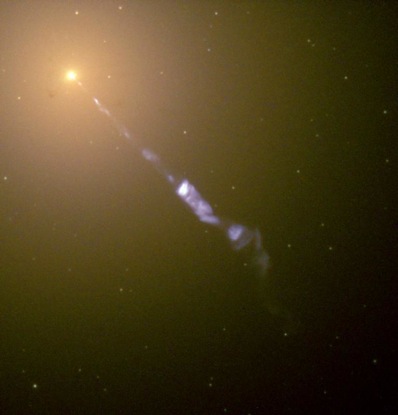



|

|

M87’s black holes gets its kicks from merger
KEITH COOPER
ASTRONOMY NOW
Posted: 26 May 2010


The supermassive black hole at the centre of the giant galaxy M87 isn’t where it is supposed to be, according to new findings presented yesterday at the American Astronomical Society’s 216th meeting in Miami. Measurements indicate that it has been kicked 71 light years from the centre of M87 by a merger with another black hole.
Messier 87, at the heart of the Virgo Cluster, is a giant elliptical galaxy, one of the biggest in the Universe, and inside it is an immense black hole 6.4 billion times more massive than our Sun. The galaxy and its supermassive black hole grew to such gigantic sizes because of mergers with other galaxies and their black holes.
 The central regions of M87, including its powerful relativistic jet. The jet is emanating from around the black hole. Image: NASA/Hubble Heritage Team (STScI/AURA). The central regions of M87, including its powerful relativistic jet. The jet is emanating from around the black hole. Image: NASA/Hubble Heritage Team (STScI/AURA).
A feature of elliptical galaxies is that they show a smooth decrease in brightness radiating away from their centre. A team led by Dr Daniel Batcheldor of the Florida Institute of Technology measured the isophotes – lines of constant brightness, akin to geographical contour lines – which centre on the topographical centre of M87. There they should have found M87’s black hole, but they found it had been offset by 71 light years. Not only does this put into question the assumption that black holes are always at the very centre of black holes, it also raises questions of what caused this state of events in the first place. Batcheldor’s team drew up four possible scenarios, including a binary black hole system, perturbations by the total gravity of the surrounding system of globular clusters, and recoil from M87’s famous jet of energy blasting out from the black hole at nearly the speed of light, before settling on what they believe is the most likely explanation: that the black hole was involved in a merger at some point in its history that gave it a kick away from M87’s centre.
They arrived at this conclusion partly because it has its own merits – galaxy mergers result in a gravitational kick that propels the black hole away from the galaxy – but also by ruling out the other possible explanations. “If it were produced by a supermassive black hole binary system, we would expect to see the second black hole exactly symmetrically opposite, and it would have a similar mass, but we see no evidence for it,” says Batcheldor. And although M87’s jet appears to be one-sided, theoretical models of such jets describe two jets blasting out in opposite directions, so although we can’t clearly see a second jet hidden behind M87, astronomers assume it is there (and there is tentative evidence for it) and this would neutralise any recoil. As for the globular clusters, of which there is over a whopping 10,000, their cumulative gravitational influence would only be able to nudge the black hole 0.3 light years. Thus a black hole merger appears to be the only viable explanation.
The size of the black hole with which it merged, and how long ago this happened, remains unknown. “One thing we’re lacking is its velocity,” says Batcheldor. “Without that information we cannot tell when it occurred. An analogy is an olive in a salad bowl. If you give it a flick it oscillates up and down the bowl, but if you observe that at any point you wouldn’t be able to tell when it was flicked. It could have happened anytime in the last ten billion years, and without knowing that we can’t extrapolate back to find the pre-merger mass ratio between the black holes.”
This isn’t the first time we’ve seen black holes get a kick from a merger, but in those cases the black holes have been shoved thousands of light years from the centre of their galaxy. Messier 87’s black hole is the smallest offset of any black hole ever seen, and its journey could be only just beginning – it may take millions or billions of years to return to rest.
|

|

|

|
|



